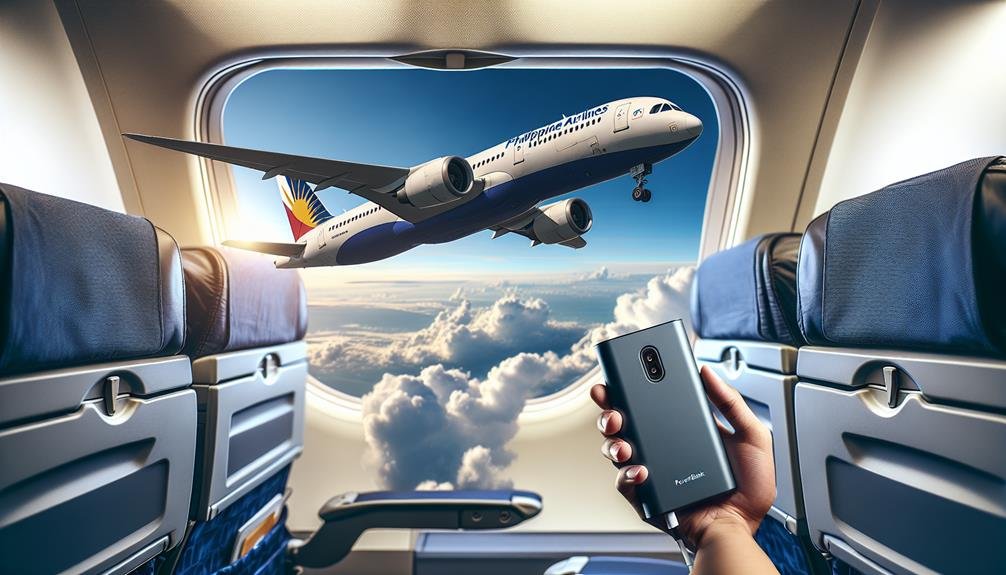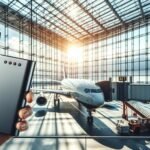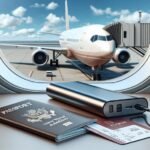Yes, power banks are allowed on Philippine Airlines, but you must follow strict guidelines. They need to be stored in your carry-on baggage and can't exceed 100 watt-hours (Wh) without approval. If between 100-160 Wh, you're limited to two power banks and need prior approval. Charging your power bank on the aircraft is prohibited to prevent safety hazards. Make sure to check the airline's policies before your flight for any updates. Interested in more detailed information on bringing power banks and ensuring compliance with regulations?
Philippine Airlines Battery Policy
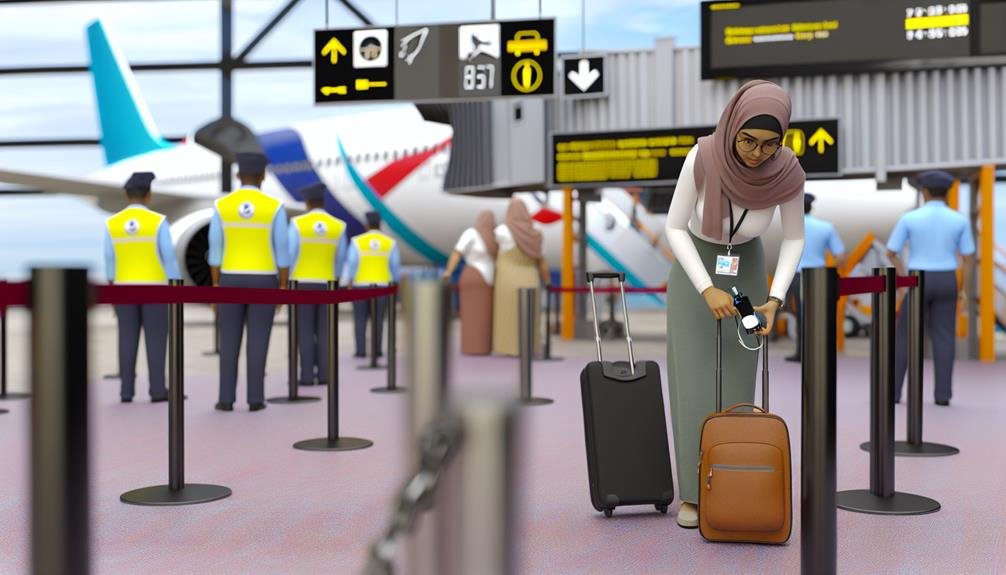
Philippine Airlines' battery policy specifies strict guidelines for carrying power banks to guarantee passenger safety. When traveling, you'll need to adhere to their power bank storage rules, which require that all power banks be kept in your carry-on baggage. This measure guarantees quick access and reduces the risk of fire hazards that could arise from thermal runaway incidents in the cargo hold.
Charging restrictions are also in place to further mitigate risks. While on the aircraft, you're not permitted to charge your power bank. This restriction aims to prevent overheating and potential malfunctions during the flight. To comply, make sure your power banks are fully charged before boarding and avoid using them to charge other devices during the flight.
Understanding these policies will help you prepare adequately for your trip. By following Philippine Airlines' guidelines, you'll contribute to a safer flying environment. Remember, the airline's primary concern is the well-being of all passengers, and these measures are designed to prevent any possible disruptions or dangers associated with power bank usage. Always check for the latest updates on their official website before you fly.
Power Bank Size Limits
When flying with Philippine Airlines, you need to be aware of specific power bank size limits. The maximum capacity allowed is 100 watt-hours (Wh) without airline approval, and you can carry up to two devices between 100-160 Wh with prior approval. Additionally, each passenger is restricted to a maximum of two power banks in their carry-on luggage.
Maximum Capacity Allowed
To ensure safety and compliance, you're allowed to carry power banks on Philippine Airlines only if their capacity doesn't exceed 100Wh without prior approval. This is a key aspect of airline regulations aimed at minimizing potential hazards associated with portable chargers. The 100Wh limit is in place to make sure that the power banks you bring on board are within a safe range, thereby adhering to international safety standards.
When selecting your travel essentials, it's important to check the capacity of your portable chargers. Power banks exceeding 100Wh but not more than 160Wh may be allowed but require prior airline approval. This charging restriction is enforced to manage risks associated with high-capacity lithium-ion batteries, which, if mishandled, can pose significant safety threats.
Therefore, before you travel, confirm the Wh rating of your power bank (often listed on the device or packaging) to avoid complications at security checkpoints. If your power bank's capacity falls within the allowable range, you can carry it in your carry-on luggage. Adhering to these guidelines ensures not only your safety but also the safety of fellow passengers and crew members during the flight.
Device Quantity Limits
Each passenger is allowed to carry a maximum of two power banks with a capacity of up to 100Wh each in their carry-on luggage. Adhering to these power bank restrictions guarantees compliance with airline regulations and enhances in-flight safety.
To clarify, power banks exceeding 100Wh but not more than 160Wh may be permitted, but you must seek prior approval from Philippine Airlines. This strict control is part of the broader electronic device allowances and travel restrictions designed to mitigate fire risks associated with lithium-ion batteries.
Here's a summary of the power bank allowances:
| Power Bank Capacity | Quantity Allowed | Approval Required |
|---|---|---|
| Up to 100Wh | 2 | No |
| 101Wh to 160Wh | 2 | Yes |
| Over 160Wh | 0 | Not Permitted |
Understanding these limits can prevent hassles at security checkpoints and secure your journey remains smooth. Always check the power bank's label for its capacity and confirm any airline-specific guidelines before traveling. By following these regulations, you're contributing to a safer in-flight environment for everyone. Remember, safety is paramount, and complying with these regulations minimizes potential risks during air travel.
Carry-On Vs. Checked Baggage
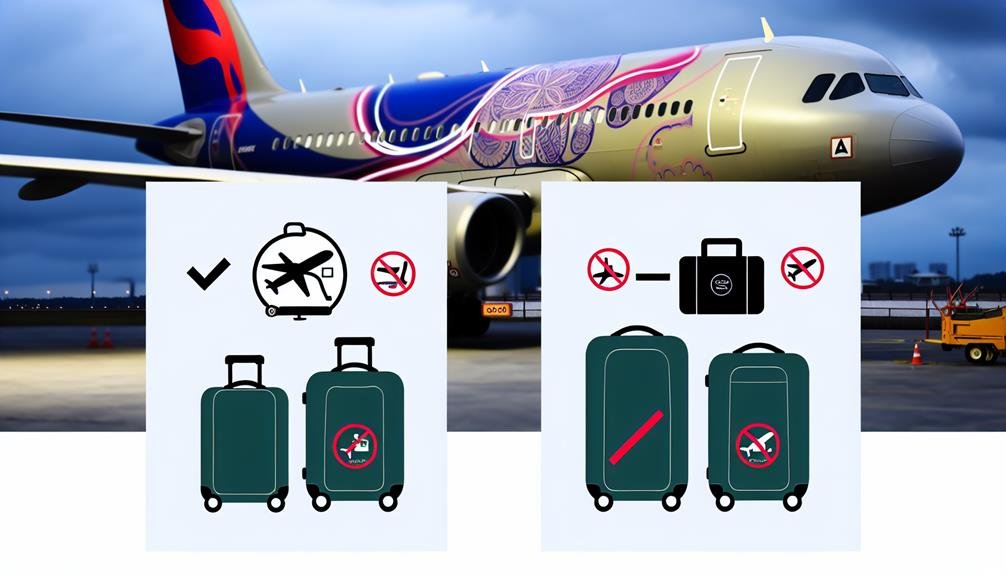
Understanding the specific regulations for carrying power banks in carry-on versus checked baggage on Philippine Airlines is essential for ensuring compliance and safety. When traveling with portable chargers, you need to be aware of travel restrictions that dictate how and where these devices can be stored during your journey. Philippine Airlines mandates that all battery packs, including power banks, must be carried in your carry-on luggage. This regulation is in place to mitigate risks associated with potential overheating or fire hazards, which are more manageable in the cabin than in the cargo hold.
You should never place power banks in your checked baggage, as this contravenes luggage regulations set forth by aviation authorities. Carry-on storage allows for immediate intervention in case of any malfunction, ensuring the safety of all passengers on board. Additionally, power banks must remain off and stored safely during the flight to prevent accidental activation. Adhering to these guidelines is not just a matter of regulatory compliance but an essential aspect of in-flight safety. By following these rules, you contribute to a safer travel environment for yourself and others, demonstrating responsible travel behavior.
Lithium-Ion Battery Regulations
Lithium-ion battery regulations on Philippine Airlines are strict, designed to guarantee passenger safety and compliance with international aviation standards. These regulations are essential because lithium battery fires are a significant risk. Here's what you need to know about these safety measures:
- Carry-On Only: Lithium-ion batteries and devices containing them must be in your carry-on baggage, not checked luggage, to facilitate immediate access in case of a fire.
- Battery Capacity Limits: Each battery must not exceed 100 watt-hours. For larger batteries, special airline approval is required.
- Battery Disposal and Recycling: Proper disposal and recycling of batteries are vital. Never discard lithium-ion batteries in regular trash bins, as they can ignite fires.
- Device Protection: Devices must be safeguarded against accidental activation. Use covers, cases, or tape to prevent short-circuiting.
- Spare Batteries: You're allowed to carry up to two spare batteries, but they must be individually safeguarded to prevent short circuits.
These regulations are meticulously designed to prevent lithium battery fires and secure your flight's safety. By adhering to these guidelines, you contribute to a safer travel environment for everyone. Always check with the airline for any updates or additional rules before you fly.
Watt-Hour Calculation Guide
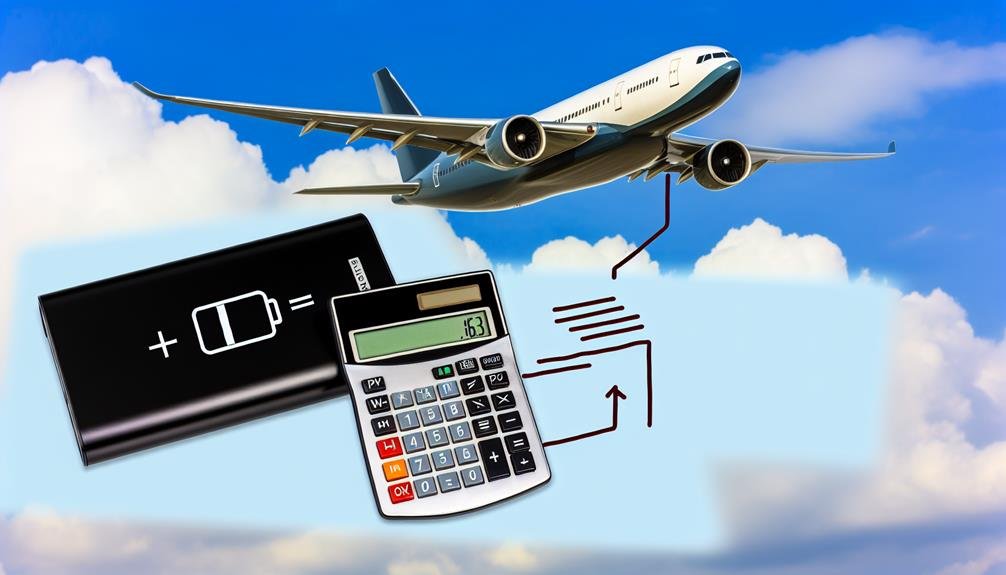
Ever wondered how to calculate the watt-hour (Wh) rating for your power bank to make sure it complies with airline regulations? Watt-hour conversion is essential for adhering to travel restrictions, particularly when flying with Philippine Airlines. To determine the Wh rating, you'll need two pieces of information: the battery capacity in milliampere-hours (mAh) and the voltage (V).
Here's the formula:
\[ ext{Wh} = rac{ext{mAh} imes ext{V}}{1000} \]
For example, if your power bank has a capacity of 20,000 mAh and operates at 3.7 volts, the calculation would be:
\[ ext{Wh} = rac{20,000 imes 3.7}{1000} = 74 ext{Wh} \]
Philippine Airlines' regulations typically allow power banks up to 100 Wh in carry-on luggage without needing special permission. For power banks between 100 and 160 Wh, you may need airline approval. Power banks exceeding 160 Wh are generally prohibited.
Understanding this calculation guarantees you comply with airline regulations, avoiding potential travel restrictions. Always check the manufacturer's specifications for accurate battery capacity and voltage before you travel. This analytical approach assures your journey remains smooth and safe.
Safety Precautions for Power Banks
Making sure your power bank is safe for travel involves several crucial precautions to prevent potential hazards. First, always adhere to proper charging etiquette. Overcharging can lead to overheating and battery damage. Unplug the power bank once it's fully charged.
Pay close attention to battery maintenance. Regularly inspect your power bank for any signs of wear or damage, such as bulging or leaking, and discontinue use if any issues are detected.
Opt for reputable power bank brands. They are more likely to comply with safety standards and provide reliable performance. Avoid counterfeit products, which may not meet essential safety criteria.
Consider these key safety measures:
- Use only the manufacturer's charging cables and adapters. Incompatible accessories can cause malfunctions.
- Store in a cool, dry place. Extreme temperatures can degrade battery life and pose safety risks.
- Avoid physical damage. Dropping or crushing your power bank can compromise its integrity.
- Check airline regulations. Make sure your power bank's watt-hour rating complies with Philippine Airlines' guidelines.
- Carry as a travel accessory in hand luggage. This precaution allows for immediate response in case of emergencies.
Alternative Charging Solutions
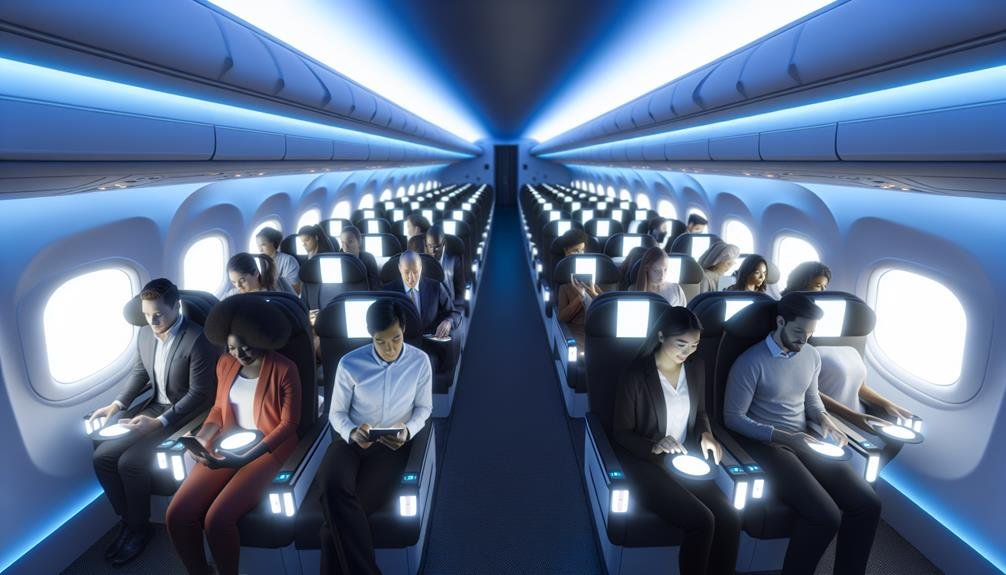
While following safety measures for power banks is crucial, you might also want to explore alternative charging options for your devices when traveling on Philippine Airlines. One viable option is solar chargers. These devices convert sunlight into electricity, offering a renewable and secure energy source. Solar chargers are especially helpful during extended layovers or outdoor activities, where access to standard power sources is limited. Confirm that your solar charger is compact and airline-approved to prevent any issues during your journeys.
Another effective alternative is portable generators. These devices can provide significant power output and come with multiple charging ports. However, when choosing a portable generator, prioritize those specifically designed for travel, making sure they adhere to airline regulations regarding battery capacities and hazardous materials. Lightweight and compact models are preferred, as they are easier to transport and less likely to pose problems during security checks.
Both solar chargers and portable generators offer dependable, on-the-go charging options, reducing your reliance on traditional power banks. By considering these substitutes, you not only improve your travel convenience but also follow Philippine Airlines' safety guidelines, leading to a smoother travel experience.
Contacting Philippine Airlines for Updates
Contacting Philippine Airlines for the latest updates on power bank regulations ensures you have accurate and current information for your trip. Given that airlines frequently revise their policies, staying well-informed is vital for ensuring your safety and compliance.
To initiate the inquiry process, reach out to Philippine Airlines' customer service. This step will help you understand any recent policy changes or updates. Here are recommended methods for contacting them:
- Phone: Directly call their customer service hotline for real-time assistance.
- Email: Send a detailed inquiry to their official email address for documented responses.
- Website: Visit the Philippine Airlines website for the latest updates on their policies.
- Social Media: Use their official social media channels for quick responses.
- In-Person: Visit a Philippine Airlines office for face-to-face interaction and detailed explanations.
Frequently Asked Questions
Can I Use My Power Bank During the Flight?
Yes, you can use your power bank during the flight, but follow charging etiquette. Keep it in your carry-on, make sure it's within airline limits, and use it to enhance your in-flight entertainment safely and responsibly.
Are Solar-Powered Power Banks Allowed on Philippine Airlines?
Think of airline regulations as a tightrope walk. Solar-powered devices, like any electronic devices, must comply with specific airline regulations. Check with Philippine Airlines and customs for detailed guidelines to guarantee your device is allowed.
Is There a Limit on the Number of Power Banks I Can Carry?
Regarding the current question, power bank regulations do apply. You're allowed to carry on a maximum of two power banks within the carry-on limits. Each power bank must not exceed a capacity of 100Wh for safety compliance.
Are There Any Specific Brands of Power Banks That Are Prohibited?
You're worried about specific brands, but it's not about brands; it's about power bank size restrictions and power bank charging capabilities. Confirm your power banks comply with safety standards, especially regarding watt-hour limits and proper certification.
How Should I Pack My Power Bank to Ensure Compliance?
Imagine Jane secured compliance by packing her power bank in her carry-on. Follow these packing tips: place it in your hand luggage to meet safety regulations and travel restrictions, securing it's easily accessible for inspection.

